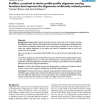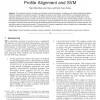62 search results - page 2 / 13 » CONTRAlign: Discriminative Training for Protein Sequence Ali... |
BMCBI
2005
13 years 5 months ago
2005
Background: Profile-profile methods have been used for some years now to detect and align homologous proteins. The best such methods use information from the background distributi...
BMCBI
2007
13 years 5 months ago
2007
Background: For successful protein structure prediction by comparative modeling, in addition to identifying a good template protein with known structure, obtaining an accurate seq...
BMCBI
2008
13 years 5 months ago
2008
Background: We present a novel method of protein fold decoy discrimination using machine learning, more specifically using neural networks. Here, decoy discrimination is represent...
JCB
2002
13 years 5 months ago
2002
We describe a new algorithm for protein classi cation and the detection of remote homologs. The rationale is to exploit both vertical and horizontal information of a multiple alig...
TCBB
2008
13 years 5 months ago
2008
The subcellular locations of proteins are important functional annotations. An effective and reliable subcellular localization method is necessary for proteomics research. This pap...


